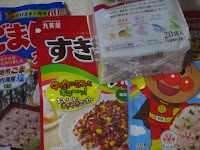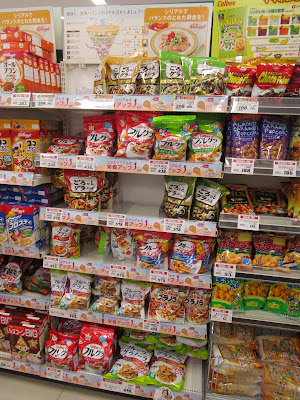 Here in Japan shopping is a totally different experience than it was stateside. In the U.S. I knew where everything was located, what price to expect, and I could identify ingredients by sight or smell or I could read the label. None of those things are necessarily true here in Japan. Instead, even a trip to the store at first was overwhelming and incredibly fun because I didn't know what to expect. It is still a challenge to shop, but I am becoming more familiar with many of the products on the shelves. To the left is a giant bag of salt. It is not the Japanese version of the Morton salt girl... it is the mascot for the region that the salt was harvested in, but it is one of the many ways that the simple, mundane, and stark differences between America and Japan slaps me in the face in the supermarket.
Here in Japan shopping is a totally different experience than it was stateside. In the U.S. I knew where everything was located, what price to expect, and I could identify ingredients by sight or smell or I could read the label. None of those things are necessarily true here in Japan. Instead, even a trip to the store at first was overwhelming and incredibly fun because I didn't know what to expect. It is still a challenge to shop, but I am becoming more familiar with many of the products on the shelves. To the left is a giant bag of salt. It is not the Japanese version of the Morton salt girl... it is the mascot for the region that the salt was harvested in, but it is one of the many ways that the simple, mundane, and stark differences between America and Japan slaps me in the face in the supermarket.  Curry and rice is my staple. Throw some rice in the rice cooker and veggies in a pot with curry stock and presto, a thirty minute meal. Japanese curry tastes different from Indian or Thai curry. It is savory and thick and brown. It has fish bits in it, although it does not taste particularly fishy. My favorite veggies to add are carrots and daikon (giant turnip, pictured later) and potatoes. The curry flavors usually come in sweet, medium, and spicy (which is not particularly spicy) in a smattering of brands and flavors. Most stores have a whole aisle or a large portion of an aisle devoted to curries.
Curry and rice is my staple. Throw some rice in the rice cooker and veggies in a pot with curry stock and presto, a thirty minute meal. Japanese curry tastes different from Indian or Thai curry. It is savory and thick and brown. It has fish bits in it, although it does not taste particularly fishy. My favorite veggies to add are carrots and daikon (giant turnip, pictured later) and potatoes. The curry flavors usually come in sweet, medium, and spicy (which is not particularly spicy) in a smattering of brands and flavors. Most stores have a whole aisle or a large portion of an aisle devoted to curries.
Below are snacks.
The yellow bag has freeze dried fish and nuts, the pink one has wasabi nuts, and the third one has freeze dried soup which tastes better than I expected.
One thing which is readily available in both grocery stores and even conbinis is flavor packets for rice. Below is a picture of several choices. Flavors usually include egg, meat, seaweed, and ume (pickled plum). You can add them to onigiri (rice balls) or ochazuke (a soup made from rice, flavor packets, and green tea) or bento boxes. Whatever strikes your fancy.
Behold, cereal. The breakfast of champions.
Cereal is actually a somewhat common breakfast food in Japan (alongside fish, rice, miso soup, and salad) so it can be found in every supermarket and in most conbinis. However, it is lacks the variety of American cereals...
 Here are some of the most common variations on cereal. There is the fibrous nuts and twigs of All bran and occasional boxes of cornflakes which are neither as cheap nor as sugary as in America, but most of the cereals are a combination of puffed rice, dried fruit, uncooked oats, and nuts. It's actually pretty good. Unfortunately, cereal is always sold in tiny boxes. I miss the giant, family-sized, cheaper version of cereal.
Here are some of the most common variations on cereal. There is the fibrous nuts and twigs of All bran and occasional boxes of cornflakes which are neither as cheap nor as sugary as in America, but most of the cereals are a combination of puffed rice, dried fruit, uncooked oats, and nuts. It's actually pretty good. Unfortunately, cereal is always sold in tiny boxes. I miss the giant, family-sized, cheaper version of cereal.  The egg sign to the left is reminding customers that, if the eggs are near their expiration date, then you should cook them before eating them... Oh, and you should probably put them in a fridge at some point. Eggs are an incredibly important staple in the Japanese diet. So much so that it is hard to find a restaurant menu that does not boldly feature it. Japan has even invented an egg man/creature/mascot named Gudetama which is both endearing and disturbing.
The egg sign to the left is reminding customers that, if the eggs are near their expiration date, then you should cook them before eating them... Oh, and you should probably put them in a fridge at some point. Eggs are an incredibly important staple in the Japanese diet. So much so that it is hard to find a restaurant menu that does not boldly feature it. Japan has even invented an egg man/creature/mascot named Gudetama which is both endearing and disturbing.This reminder/sign is pertinent in Japan - unlike in America - because many dishes include raw egg or barely cooked eggs.
Those dishes are usually delicious, too.



For those of you who are calculating this at home, yes, it is almost a dollar per loquat and the boxed cantaloupe is $50 (and here it is called a melon メロン, not cantaloupe). If the apples seem like a decent price, then remember that the apples are sold "each" not per pound. Of course, my British friend reminds me that I am spoiled by Florida fruit prices (being close to the equator), but I think fruit is generally cheaper across the entire U.S. than in Japan.
Cucumbers and daikons.
Don't let the pictures fool you. Both are between 12 inches and 18 inches long. The diameter of most daikons is 4 inches. Both of these are delicious. Daikons are the veggies I now use the most. It is a root vegetable like a radish or turnip but it lacks their distinct flavor. It is also more starchy. Because of its relatively bland flavor it can be readily added to any number of dishes.
Below are a series of foods in a refrigerated section between the veggies and fish. Some of the labels are helpful to me, others less so. Some look like seaweed and others like plum, but as a general collection I still don't have a clue what they are.
Meat? Veggie?
I have a rule of thumb that if I have to ask that question then I am not allowed to buy it.
竹の子竹の子
Bamboo Shoots
There are some fantastic videos by one of my favorite vloggers about how to hunt and cook bamboo.
Harvesting: https://www.youtube.com/watch?v=PUP99jANwdE
Cooking: https://www.youtube.com/watch?v=I8L-Y4zzJuI
Flowers are also sold in the veggie aisle for food decoration/presentation.
The rest of these are just broad photos of aisles.
Here is the spaghetti aisle. Spaghetti is HUGE here... but I have yet to taste something that I would call "spaghetti sauce".
Green Tea
(see my other article on green tea: http://linguadiscipuli.blogspot.jp/2016/04/green-tea.html)
Rice! So many different kinds of short-grain, white rice...
Who knew?
The entire cereal selection in a bigger store.
Also, boxed sake is a huge thing in both the grocery stores and the conbinis.
According to the people I ask, there is not a stigma to boxed wine like there is in America.
Also, instead of using wine in cooking like you would in some French recipes, the Japanese have their own sauce/spice called mirin which is basically sugar and sake mixed.
That was a taste of shopping in Japan.
I hope you enjoyed and I hope that any Americans reading this are inspired to visit an Asian market near you.
























But going to the market is only fun if you're there ;)
ReplyDelete